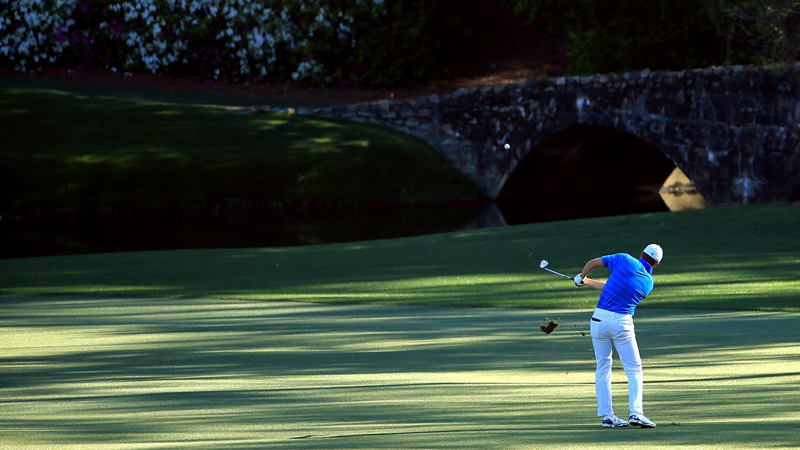Why Leaving A Full Shot To The Green Will Save You Strokes
Fergus Bisset thinks it will, Jeremy Ellwood doesn’t agree…


Fergus Bisset thinks approaching the green with a full shot is always preferable to facing a tricky little pitch… Jeremy Ellwood doesn’t agree…
Why Leaving A Full Shot To The Green Will Save You Strokes
Hit a full shot
says Fergus Bisset
For those with the touch of Phil Mickelson, playing down close to a green where short game wizardry can come to the fore may well be a desirable option.
But for the 99% of golfers whose touch is more akin to Phil Mitchell’s, leaving a full wedge shot into a green is preferable.
There are few shots in golf that are more difficult to judge and execute than a half shot or pitch from relatively close range.
Get the Golf Monthly Newsletter
Subscribe to the Golf Monthly newsletter to stay up to date with all the latest tour news, equipment news, reviews, head-to-heads and buyer’s guides from our team of experienced experts.
How much swing to take, how much power to take off, will it spin, will I catch it clean?
There’s so much that can go wrong and so little chance for amateur golfers to get it absolutely spot on.
The super-destructive duff or knife are all too possible, and they get into the head.
With a full shot from a favoured yardage, the equation is simple – make a good swing, hit it firmly and the result will be reasonable at worst and excellent at best.
A full shot with a wedge will stop quickly when fired into all but the firmest greens, allowing you to control the distance effectively.
If you know how far each of your scoring clubs goes with a full swing, and you know the exact yardage to the pin, you’ll have a clear game plan.
From shorter range, indecision will creep in. Whether to loft it and attempt to get it to stop quickly or to allow for more run – that indecision can lead to a lack of commitment, a deceleration and disaster.
In a pressure situation, what would you rather face – a full swing from 100 yards where you can give it a bit of welly, or a fiddly pitch from 40 yards that requires smooth finesse and a perfect contact? I know where I stand – full shot every time.
Why Leaving A Full Shot To The Green Will Save You Strokes
Play for the pitch
says Jeremy Ellwood
This debate really comes to the fore on short par 4s and certain par 5s where you face strategic choices.
Do you try to chase it down there as far as possible, leaving a mere flick or pitch in, or do you hold back or lay up to leave a fuller approach?
The sensible choice must be to maximise distance if relatively safe to do so for one simple reason – for most golfers, the shorter the shot, the closer to the flag they’re likely to hit it.
The full shot merchant will argue that longer approaches generate more spin and therefore greater control.
But at club level, we misjudge, mis-strike or misclub full shots far more often than the world’s best, and what control we do have will be of little benefit if we’re 15 yards long, short or wide.
Even the best iron player on the PGA Tour from 125 to 150 yards – not surprisingly Collin Morikawa in 2021 – averages 16ft 5ins from the pin.
The reality is that for club golfers, the fuller the swing, the more scope there is for something to go badly wrong.
The clubface doesn’t have to be involuntarily twisted many degrees open or closed for accuracy to drop off dramatically. The more compact the swing, as with a pitch, the less likelihood there is of the clubface getting so far out of sync.
And even if it does, a couple of degrees out from 50 yards will only equate to a relatively minor miss.
The moral of the tale therefore is: to increase the number of birdie chances you create, play to leave yourself as many pitch approaches as the course sensibly allows. Yes, it may sometimes backfire, but overall you will score better.

Fergus is Golf Monthly's resident expert on the history of the game and has written extensively on that subject. He has also worked with Golf Monthly to produce a podcast series. Called 18 Majors: The Golf History Show it offers new and in-depth perspectives on some of the most important moments in golf's long history. You can find all the details about it here.
He is a golf obsessive and 1-handicapper. Growing up in the North East of Scotland, golf runs through his veins and his passion for the sport was bolstered during his time at St Andrews university studying history. He went on to earn a post graduate diploma from the London School of Journalism. Fergus has worked for Golf Monthly since 2004 and has written two books on the game; "Great Golf Debates" together with Jezz Ellwood of Golf Monthly and the history section of "The Ultimate Golf Book" together with Neil Tappin , also of Golf Monthly.
Fergus once shanked a ball from just over Granny Clark's Wynd on the 18th of the Old Course that struck the St Andrews Golf Club and rebounded into the Valley of Sin, from where he saved par. Who says there's no golfing god?
-
 Justin Thomas Confirms Stand-In Caddie Will Not Replace Long-Term Looper After First Victory Since 2022
Justin Thomas Confirms Stand-In Caddie Will Not Replace Long-Term Looper After First Victory Since 2022Thomas won the RBC Heritage with Max Homa's former looper, Joe Greiner as his assistant but is looking forward to welcoming his regular caddie back soon
By Jonny Leighfield
-
 Rose Zhang Ruled Out Of Chevron Championship
Rose Zhang Ruled Out Of Chevron ChampionshipThe American hasn't featured in a competitive event since withdrawing from the T-Mobile Match Play, with it reported that Zhang will miss the Chevron Championship due to an ongoing neck injury
By Matt Cradock